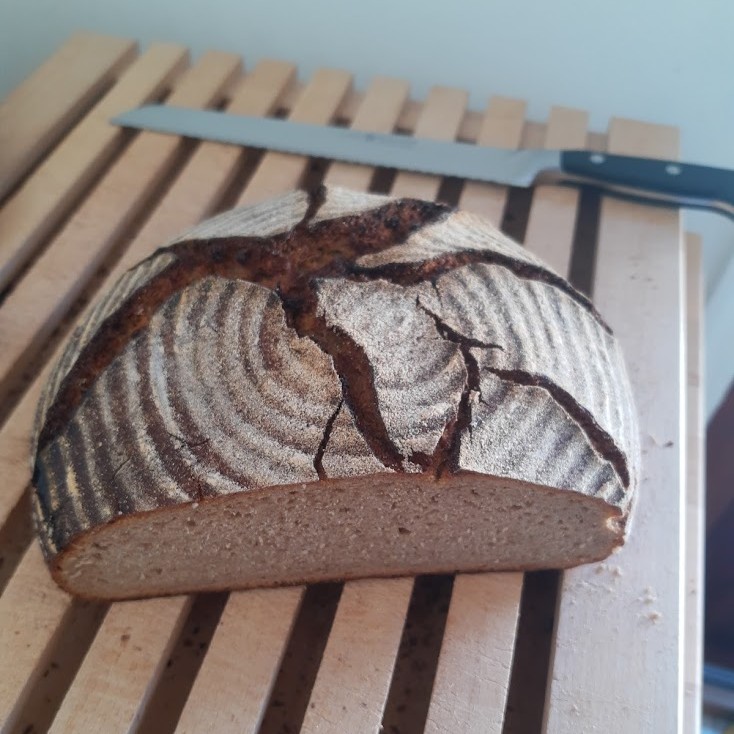Several of the recipes in Stanley Ginsberg’s The Rye Baker use first clear flour with the rye flour. Using high-gluten flour is also an option in these recipes. I am trying to avoid purchasing another flour that won’t be used often enough to justify its purchase. My understanding is that the first clear flour not only provides dough strength for the rye, but also imparts a color and flavor that patent flour will not.
Ginsberg suggests adding vital wheat gluten to bread flour to increase the protein level to mimic high-gluten flour. He also suggests blends of rye flours to approximate European rye flours that are not available in the U.S. My question, then, is there any merit in blending a small amount of whole wheat flour with high-gluten flour to mimic the color and ash content of first clear flour?
Thanks!
At least to my understanding, first clear flour is a "leftover" product: if you start with whole-grain flour, first sieve off the coarsest bran, and then sieve out an AP-like flour, the fraction left after these two are removed is the "first clear." This is higher protein/ash concentration than the AP because most of the starch has gone to the AP flour, but that protein is not all gluten - in fact, much of the gluten will be in the AP fraction!
Ginsberg even explains this misconception himself on his blog: http://theryebaker.com/in-defense-of-first-clear/

So taking a bread flour, and adding more gluten to it, seems to be going the wrong direction - these ingredients are exactly what the first clear flour does not have, because they have been sifted out! The result will be a flour which technically has the same ash content number as first clear, but in practice completely different composition, baking properties and flavor. I frankly don't understand why Ginsberg recommends this - but maybe I am missing something, in which case I hope a more knowledgeable forum member can correct me.
I would think that if you just use whole-wheat flour, or better yet whole-wheat flour from which you've sieved out the bran, you will come closer to the flavor profile of the first clear - and you won't need to buy any "special" first clear flour.
Interesting anecdote from my own experience: I recently sourced some T55-like flour from a friend who volunteers at a small local mill (in the Netherlands); rather than throwing them out, he also gave me the coarse bran and the "in between" fractions, mentioning the latter would be similar in total ash to a German 1050 flour.
Quite a few German "Roggenmischbrot" recipes call for 1050 flour for the wheat fraction - below an example of a 70/30 rye/wheat I baked using such a recipe with the "first clear." In a recipe like this, the first clear wheat flour is adding strength and mellowing the flavor and texture compared to using 100% rye - but less so than if I had used bread flour. But it is a great way to turn a "waste" product into a tasty bread, which as Ginsberg himself says is probably why it was used by NY bakers in the first place.
Cheers,
Mike
Mike,
That's a nice looking loaf!
I'm not sure I have the appropriate sieve mesh to remove the bran from whole wheat flour. Breadtopia sells a bolted bread flour that might be a good approximation. It has 14% protein but no ash content is listed; I will ask Breadtopia for the value. Ardent Mills' Powerful first clear flour has 14% protein and 0.8% ash.
Thanks!
Mike,
That loaf looks awesome! I've just started trying to figure out how to make the breads I enjoyed when I lived in Germany; would you mind sharing your baker's formula?
Thanks! That bread was 70% 1150-grade rye flour and 30% "first clear" wheat flour (the original recipe called for 1050-type wheat flour). Half of the rye (35% on total) was used for the levain/"vorteig."
Maybe much more useful than the above, though: I got the recipe from Lutz Geißler's "Brotbackbuch #2." This has recipes for a wide variety of standard German breads - if you learned a bit of German while living there, this might be very helpful resource for exploring German-style baking.
Cheers, Mike